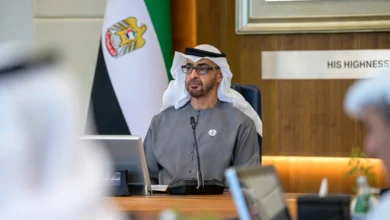
UAE Tourism Hits Record $12.2B as Hotel Guests Surge 9.5%
UAE’s tourism sector achieved record-breaking success in 2024. Hotel revenues soared to AED 45 billion (US$12.3 billion) while guest numbers climbed to 30.8 million. The hospitality sector demonstrated impressive growth with a 9.5% rise in hotel guests and a 3% revenue increase compared to the previous year.
The country’s hotel industry maintained a stellar 78% occupancy rate in 2024, ranking among the top performers regionally and globally. The sector has already reached 77% of its National Tourism Strategy 2031 objectives, significantly ahead of schedule. Dubai’s strong performance continued with 3.82 million international visitors in early 2025. These numbers suggest the UAE will likely achieve its ambitious target of 40 million hotel guests by 2031.
UAE Achieves Record $12.2B Tourism Revenue in 2024
The UAE’s hospitality sector had an outstanding year in 2024 and proved itself as a global tourism leader. Abdulla bin Touq Al Marri, Minister of Economy and Chairman of the Emirates Tourism Council, reported that tourism brought in AED 45 billion (about US$12.2 billion) in hotel revenues throughout 2024.
Hotel Revenues Jump 3% Year-over-Year
UAE’s hotel revenues grew steadily by 3% compared to 2023. This growth shows how well the country built its tourism brand despite global economic challenges. Hotels generated over AED 24.6 billion in the first half of 2024, which was 7% more than the same period in 2023.
Several factors led to these impressive revenue numbers:
- More hotels opened across all seven emirates
- Strong marketing campaigns in key international markets
- Better visitor experiences and hospitality services
- New tourism-friendly policies and improved infrastructure
Guest numbers soared too, with about 30.8 million people staying in UAE hotels during 2024. This was 9.5% more than the previous year, showing the sector had not just recovered but grown beyond pre-pandemic levels.
Occupancy Rates Climb to 78% Globally
The UAE reached a remarkable 78% hotel occupancy rate in 2024, making it one of the top hospitality markets worldwide. These numbers are even more impressive because they came while new hotels were opening, which shows real growth in demand rather than just limited room supply.
Hotels did even better in the first half of 2024, with 79.5% occupancy and 3.7% growth compared to early 2023. These strong numbers, despite more rooms being available, show UAE’s appeal to visitors throughout the year, breaking the usual seasonal patterns seen in many tourist spots.
UAE’s hospitality sector kept growing in 2024 as 16 new hotels opened across the seven emirates. By year-end, the country had 1,251 properties, which shows investors believe strongly in the market’s future.
Room numbers grew to 216,966 by late 2024, up 3% from the previous year. Despite more rooms being available, performance stayed strong. Dubai, UAE’s biggest tourism market, kept its Average Daily Rate (ADR) competitive at AED 538, just slightly above 2023’s AED 536.
Revenue Per Available Room (RevPAR) in Dubai reached AED 421 in 2024, up 2% from AED 415 in 2023. This shows how well the market balanced growth with profits, keeping rates attractive for visitors while delivering returns for investors and operators.
Tourism’s strong performance created jobs and boosted related industries like retail, transportation, and food service across the UAE.
Dubai Leads Growth as International Visitors Increase 4%

Image Source: Government of Dubai Media Office
Dubai managed to keep its spot as the UAE’s tourism powerhouse in 2024. The city welcomed a record 18.72 million international overnight visitors, which shows a 9% increase from 17.15 million visitors in the previous year. This outstanding performance substantially boosted the UAE’s tourism growth and revenue.
Key Source Markets Drive Tourism Surge
Visitors came from a variety of geographical regions. North East and South East Asia together led the growth with a 24% increase. Africa saw a 20% rise in visitors, while CIS and Eastern Europe recorded a 16% increase. Western Europe remained Dubai’s biggest source market as visitor numbers grew by 14%.
India led all source markets with over 2.2 million visitors to Dubai, making up 12.8% of all international arrivals. Oman took second place with 1.57 million visitors (9.1% share), and Saudi Arabia followed with 1.45 million visitors (8.5%). Other major contributors included:
- United Kingdom: 1.25 million visitors (7.3% share)
- Russia: 905,520 visitors (5.3% share)
- United States: 704,865 visitors (4.1% share)
This mix of visitors has become crucial to Dubai’s resilience and growth in tourism. The city can now better handle changes in individual markets.
Luxury Segment Outperforms Regional Competitors
Dubai’s hospitality sector showed remarkable strength throughout 2024. Hotel occupancy rates climbed to 78.2%, up from 77.4% in 2023. The luxury segment proved particularly strong and made up 70% of new supply in the market.
Dubai’s hotel inventory grew to 154,016 rooms across 832 establishments by December 2024, up from 150,291 rooms in 2023. The city plans to add 4,620 more rooms in 2025. Projections indicate the total room inventory will reach 162,600 across 769 hotels by 2027.
Dubai hotels’ average daily rate (ADR) stayed competitive at AED 538, slightly higher than AED 536 in 2023. Revenue per available room (RevPAR) rose by 2% to AED 421. These numbers put Dubai in a strong position compared to other global cities like Paris, New York, London, and Singapore.
Strategic marketing campaigns in more than 60 countries helped boost the emirate’s tourism growth. Dubai’s status as a premier destination got another boost when it won recognition as the world’s leading shopping and exhibition destination at the 31st World Travel Awards.
Dubai’s mix of diverse visitors, strategic growth, and strong infrastructure makes it the driving force behind UAE’s tourism sector. This success helps achieve the country’s economic diversification goals.
Hotel Sector Expands with 16 New Properties Opening
UAE’s hotel sector saw rapid expansion throughout 2024. Sixteen new properties opened across the seven emirates. The country’s total hotel count reached 1,251 establishments by year-end. This growth in hospitality infrastructure helped accommodate rising visitor numbers.
Room Inventory Grows to Nearly 217,000
By December 2024, UAE’s hotel room supply hit 216,966 keys, showing a 3% increase from the previous year. This expansion supported 30.8 million hotel guests. The country maintained high occupancy rates even as inventory grew.
Dubai led the way as the main tourism hub. The emirate’s room count grew to 154,016 across 832 establishments by 2024’s end. Dubai’s growth will continue with 4,620 more rooms opening in 2025. Total inventory should exceed 162,600 rooms by 2027.
Abu Dhabi’s plans are just as ambitious. The emirate wants to boost its hotel room supply from 34,000 to 52,000 keys as part of its Tourism Strategy 2030. This move supports Abu Dhabi’s goal to attract 7.2 million international overnight visitors by 2030 – a 90% jump from 2023 levels.
Ras Al Khaimah adds to UAE’s growing hospitality portfolio. The emirate expects 8,764 new rooms to enter the market by 2030. Knight Frank’s analysis shows a strong development pipeline that will improve its appeal as a nature tourism destination.
Investment Confidence Remains Strong Despite Global Uncertainty
Investor confidence in UAE’s tourism sector stays high despite global economic challenges. UAE’s hospitality sector plans to add nearly 27,000 more hotel rooms by 2030. This will increase total inventory to 238,412 keys – a 12.7% growth from current levels.
Dubai claims two-thirds of this new supply (17,750 rooms). This aligns with the D33 Agenda’s vision to make the city a top three global destination for leisure and business by 2033. Palm Jebel Ali and Dubai Islands will feature 160 hotels and resorts, adding much to this growth.
International brands dominate the investment landscape. They will operate 82% of the country’s hotel supply by 2030, while local brands’ share drops to 10%. Global operators Accor and Marriott International manage over 46,000 keys and have 5,400 more in development.
UAE’s tourism strategy goes beyond building infrastructure. The sector plans to create 178,000 new hospitality jobs. This strengthens its position as the life-blood of the national economy that already supports 809,000 jobs nationwide.
UAE Surpasses Tourism Targets Seven Years Early
The UAE has achieved a remarkable milestone by completing 77% of its Tourism Strategy 2031 targets seven years ahead of schedule. This accelerated progress shows the success of the country’s complete tourism development plan, launched in 2022 as part of the ‘Projects of the 50’ initiative.
National Strategy 2031 Milestones Already 77% Complete
The tourism sector made a substantial contribution of AED 220 billion to the national gross domestic product in 2023, which represents 11.7% of the economy. These numbers demonstrate major progress toward the strategy’s goal to increase tourism’s GDP contribution to AED 450 billion by 2031. The sector projects growth to AED 236 billion (12% of GDP) in 2024 that indicates steady advancement.
Guest numbers at hotels have surged dramatically. The country welcomed 30.8 million visitors in 2024, reaching 77% of the strategy’s target of 40 million hotel guests by 2031. The sector has generated 809,000 jobs in tourism activities of all types, making up 12.3% of the UAE’s total labor market.
Minister Outlines Path to 40 Million Annual Guests
H.E. Abdulla bin Touq Al Marri, Minister of Economy and Chairman of the Emirates Tourism Council, highlights four key directions for strategy implementation:
- Building a stronger unified national tourism identity
- Creating and varying specialized tourism products
- Developing tourism capabilities and encouraging national participation
- Growing investments in all tourism sectors
“Under the wise leadership’s directives, the UAE’s tourism industry is experiencing significant growth and diversification,” stated Al Marri. “The sector’s AED 220 billion contribution to the national economy takes us halfway towards the achievement of the goal set by the UAE Tourism Strategy 2031.”
The strategy has introduced 25 initiatives and policies to boost tourism development. UAE wants to attract AED 100 billion in additional tourism investments by 2031. Global confidence in the sector remains strong, with international visitor spending reaching over AED 175 billion in 2023.
Economic Impact Ripples Through Multiple Sectors
UAE’s tourism success creates economic benefits that go well beyond the hospitality sector. These benefits now flow through the national economy and generate growth in many connected industries.
Job Creation Accelerates in Hospitality
Tourism has become a major employer in the UAE. The sector provided 809,300 jobs in 2023, which makes up 12.3% of total employment nationwide. Numbers show 23,600 new positions will be added in 2024, which will bring total tourism jobs to nearly 833,000. The sector will support about 928,000 jobs by 2034. One in nine UAE residents will work in tourism-related activities.
Real Estate Values Climb in Tourism Hotspots
Tourism has helped the UAE’s property market grow substantially. Home prices went up by 7% in 2023. Prime tourist spots like Dubai Marina and Downtown Dubai saw even better growth of 10-15%. Dubai’s real estate attracted AED 83 billion in foreign investment during 2022, which was 30% more than the previous year. Properties close to major attractions have gained value steadily. Luxury home sales reached AED 8.34 billion in 2023.
Retail and F&B Sectors Report Growth
Tourism has transformed retail and dining sectors dramatically. Tourist spending will likely reach AED 367.19 billion by 2030, up from AED 176.25 billion in 2023. Tourism’s share in UAE retail market should hit AED 66.09 billion by 2030. Fashion takes up over 70% of what tourists spend in retail. Electronics grows fastest at 9% CAGR between 2023-2028. The F&B sector should grow to AED 161.49 billion by 2029, with a yearly growth rate of 17.09%.
Global Economic Headwinds Threaten Future Growth
The UAE’s tourism sector faces potential challenges despite its recent success. Dark economic clouds loom on the horizon. FocusEconomics predicts global economic growth will slow to 1.8% with a possible recession by 2025. These economic challenges could slow down UAE tourism’s record-breaking momentum.
Recession Risks Could Affect 2025 Performance
Global travel growth forecasts for 2025 have been cut by Skift Research. The new projection stands between 2% and 5%, down from the earlier 6% to 9% forecast at the year’s start. This major revision shows growing worry about worldwide economic stability.
The UAE stands stronger than other destinations thanks to its sovereign wealth funds that help during uncertain times. However, the tourism sector remains exposed to several recession-related risks:
- Oil demand drops that could weaken overall economic conditions
- International visitors might spend less due to tight budgets
- Hotel development investments could slow down
- Tourism projects might see less investor confidence due to stock market swings
UAE stock markets have already seen major drops as global indices lost trillions in value. Some tourism segments look particularly vulnerable. High-end off-plan real estate and investment properties might see slower growth if overseas buyers become cautious.
Domestic Tourism Positioned as Potential Buffer
The UAE’s expanding domestic tourism sector could help protect against international market swings. Numbers support this approach. Dubai’s hotel guests in 2020 were 52% domestic (4.55 million visitors), up from the usual 20-25% share.
Domestic tourism brought in AED 41.49 billion of the total AED 71.24 billion tourism revenue across the UAE in 2020. This proves its value during economic downturns. The UAE Strategy for Domestic Tourism, launched in December 2020, wants to push domestic tourism revenue to AED 80 billion by 2030.
Domestic tourism currently generates about AED 41 billion. Creative campaigns like “World’s Coolest Winter” brought in AED 2 billion during its 2022-2023 run. These initiatives help build protection against possible drops in international travel.
UAE tourism has become a soaring win story with record-breaking achievements in 2024. The sector generated $12.2 billion in revenue and hosted 30.8 million hotel guests, showing remarkable growth.
The hospitality sector proved resilient with a 78% occupancy rate and added 16 new properties to its portfolio. Dubai’s outstanding numbers of 18.72 million international visitors helped establish UAE as a top global destination.
UAE has already reached 77% of its Tourism Strategy 2031 targets, which proves its initiatives are working across the emirates. Tourism’s economic effects go beyond direct revenue. The sector created over 809,000 jobs and boosted growth in retail, real estate, and food service industries.
Global economic challenges loom ahead, but UAE’s tourism sector stands on solid ground. The domestic tourism market generates AED 41 billion yearly and acts as a shield against international market changes. UAE tourism remains ready to handle future challenges while moving steadily toward its 2031 goals.




